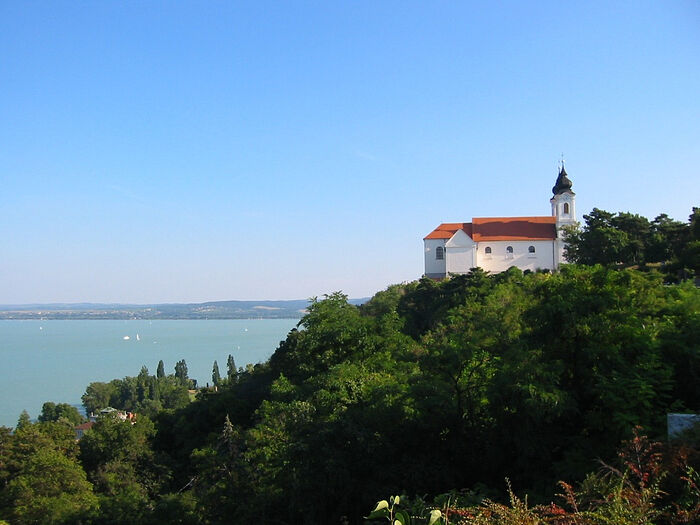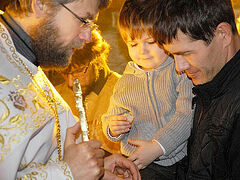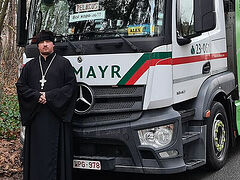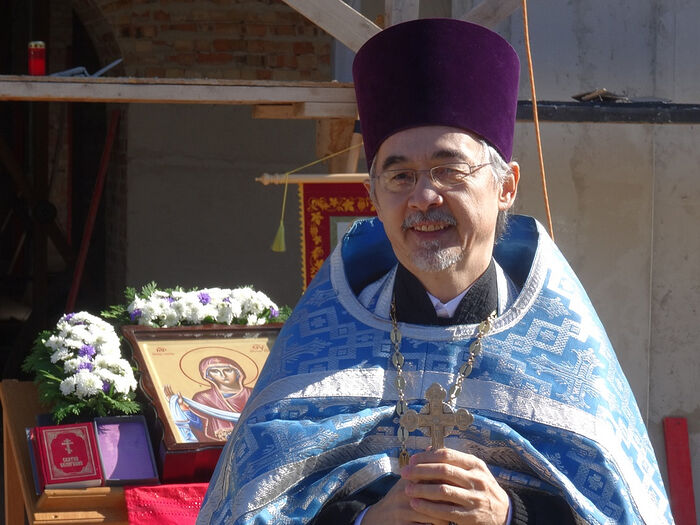 Archpriest Nikolai Kim, the rector of the Church of the “Life-Giving Spring” Icon in Heviz
Archpriest Nikolai Kim, the rector of the Church of the “Life-Giving Spring” Icon in Heviz
He was born and grew up in St. Petersburg where he was baptized in infancy, became a priest with the blessing of Elder Nikolai Guryanov in Tsarskoye Selo, and today he is bringing the light of Christ to the Hungarian lands. Archpriest Nikolai Kim is the rector of the parish of the “Life-Giving Spring” Icon of the Most Holy Theotokos in the spa town of Heviz, a cleric of the Moscow Patriarchate’s Diocese of Hungary, a Ph.D in Theology, and the administrator of the diocesan and parish Orthodox websites in Hungary. We talked on life far away from home, selfless Russian parishioners, the Orthodox way of life in any corner of the globe, Hungarian as a language of eternity, the major events in the life of the community, Hungary as a stronghold of European conservatism, the Phanar issue, total digitalization, and prayer to God as a way to sort out one’s life.
—How did you convert to the faith? Why did you decide to become a priest?
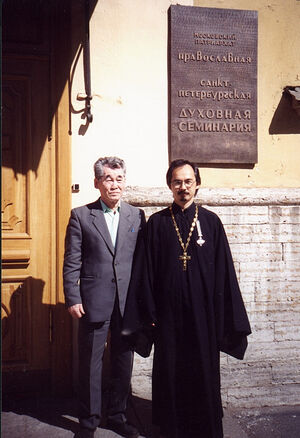 With his father after the graduation from the St. Petersburg Theological Academy, 2001 —I was baptized in infancy when my grandmother Theodosia brought me to the St. Nicholas Church at the Bolsheokhtinsky Cemetery of Leningrad—the city in which I was born and raised. St. Nicholas is the patron-saint of our family—my father’s birthday is May 22, and my nephew Nikolai was born on December 19. By coincidence, both these days are St. Nicholas’ feasts. In 2020, I turned sixty. For Koreans (my father, Anatoly Handinovich Kim, is Korean) this is the most significant milestone in life, the time to take stock of one’s life. It was from my Korean relatives that I understood what respect for one’s elders and those of higher rank is. The Korean language demonstrates respect for another person even at the grammatical level; there are three different grammatical forms: one for addressing an equal, another for your senior and a third for someone younger than you. Unfortunately, I don’t speak Korean, but acquaintance with such a complex communication system teaches delicate treatment of people and gives an idea of the existence of a certain hierarchy in society based on tradition. In 2020, I was planning a visit to Korea as part of a delegation of the Russian Orthodox Church. I was invited by Archbishop Theophan (Kim) of Korea. It would have been a wonderful experience, an acquaintance with a country and its culture I have dreamed of knowing better since childhood. However, the pandemic disrupted many plans, including that trip...
With his father after the graduation from the St. Petersburg Theological Academy, 2001 —I was baptized in infancy when my grandmother Theodosia brought me to the St. Nicholas Church at the Bolsheokhtinsky Cemetery of Leningrad—the city in which I was born and raised. St. Nicholas is the patron-saint of our family—my father’s birthday is May 22, and my nephew Nikolai was born on December 19. By coincidence, both these days are St. Nicholas’ feasts. In 2020, I turned sixty. For Koreans (my father, Anatoly Handinovich Kim, is Korean) this is the most significant milestone in life, the time to take stock of one’s life. It was from my Korean relatives that I understood what respect for one’s elders and those of higher rank is. The Korean language demonstrates respect for another person even at the grammatical level; there are three different grammatical forms: one for addressing an equal, another for your senior and a third for someone younger than you. Unfortunately, I don’t speak Korean, but acquaintance with such a complex communication system teaches delicate treatment of people and gives an idea of the existence of a certain hierarchy in society based on tradition. In 2020, I was planning a visit to Korea as part of a delegation of the Russian Orthodox Church. I was invited by Archbishop Theophan (Kim) of Korea. It would have been a wonderful experience, an acquaintance with a country and its culture I have dreamed of knowing better since childhood. However, the pandemic disrupted many plans, including that trip...
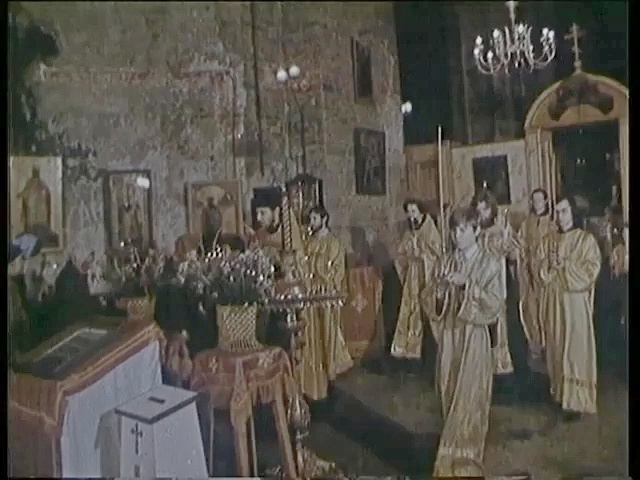 As an acolyte at the Ascension Cathedral in Tsarskoye Selo. 1991
As an acolyte at the Ascension Cathedral in Tsarskoye Selo. 1991
I graduated from a physics and mathematics school, defended my master’s thesis at the Physics and Mechanics Department of Leningrad Polytechnic Institute in 1983, worked in my field a little, including at the Agricultural Institute in St. Petersburg’s suburb of Tsarskoye Selo (the town of Pushkin)... In 1991, the restoration of the Sovereigns’ Cathedral of the Feodorovskaya Icon of the Mother of God began there. Together with other volunteers, I cleared the rubble of the devastated church, which was located not far from my home and work. I remember the significant day for me on September 29, 1991, when I first served in the altar of the Ascension Cathedral in Tsarskoye Selo (formerly known as Sophia Cathedral), exactly thirty years ago. There I met Deacon Eugene Mikhailov—now he is a much-esteemed archpriest who has revived the wonderful Church of the Protection of the Theotokos in the village of Ozera, where are relics of St. Hilarion of Gdov and Pskov Lake. With him we went to the island of Zalit, to Elder Nikolai Guryanov. I wanted to receive his blessing to serve in the altar, but the elder blessed me for the priesthood! Later I learned that the first rector of the Ascension Cathedral where I began my ministry was Archpriest Andrei Samborsky (1732–1815), who is buried at the Bolsheokhtinsky Cemetery in the church where I was baptized.
—But the main question, is how did you end up in Hungary after Tsarskoye Selo?
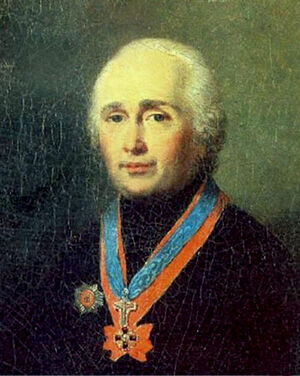 Archpriest Andrei Samborsky —Interestingly, in Hungary there was another significant link with this outstanding priest, Archpriest Andrei Samborsky whom I just mentioned. He ended up in Hungary in 1799, having arrived here as the father-confessor of the Grand Duchess Alexandra Pavlovna Romanova, who married Archduke Joseph of Austria, Palatine of Hungary. She retained her Orthodoxy in marriage, lived in Hungary for only a year and a half, and died at childbirth at the age of seventeen. Her daughter Paulina was stillborn. To perpetuate the memory of Emperor Paul I’s daughter, through the efforts of her confessor, Fr. Andrei Samborsky, an Orthodox Church in honor of the Holy Martyr Empress Alexandra was built at Üröm —on the estate of her husband Archduke Joseph. By the early twenty-first century, this Russian Orthodox church, one of the oldest in Europe, had been forgotten. Services were held once a year on May 9, and even the local press called it the “Chapel of St. George the Victorious”, some even claiming that it no longer existed...
Archpriest Andrei Samborsky —Interestingly, in Hungary there was another significant link with this outstanding priest, Archpriest Andrei Samborsky whom I just mentioned. He ended up in Hungary in 1799, having arrived here as the father-confessor of the Grand Duchess Alexandra Pavlovna Romanova, who married Archduke Joseph of Austria, Palatine of Hungary. She retained her Orthodoxy in marriage, lived in Hungary for only a year and a half, and died at childbirth at the age of seventeen. Her daughter Paulina was stillborn. To perpetuate the memory of Emperor Paul I’s daughter, through the efforts of her confessor, Fr. Andrei Samborsky, an Orthodox Church in honor of the Holy Martyr Empress Alexandra was built at Üröm —on the estate of her husband Archduke Joseph. By the early twenty-first century, this Russian Orthodox church, one of the oldest in Europe, had been forgotten. Services were held once a year on May 9, and even the local press called it the “Chapel of St. George the Victorious”, some even claiming that it no longer existed...
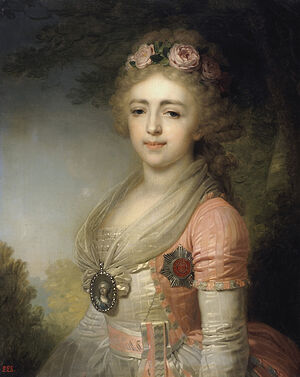 The Grand Duchess Alexandra Pavlovna Romanova When in 1999, with the blessing of Archbishop Theophan (Galinsky) of Berlin and Germany, head of the Hungarian Deanery I was received as a priest at the St. Sergius of Radonezh Church in Budapest to help its permanent rector, Archpriest John Kadar,1 I immediately noticed this abandoned church, a little piece of St. Petersburg near Budapest. In 2000 the Hungarian Deanery was transformed into the Diocese of Hungary, the first ruling hierarch of which was Bishop Pavel (Ponomarev), now Metropolitan of Kolomna and Krutitsy. In 2001, Vladyka Pavel blessed me to be engaged in the restoration of the Üröm church, and in 2003 the new ruling hierarch, Bishop Hilarion (Alfeyev) of Vienna and Budapest, now Metropolitan of Volokolamsk and chairman of the DECR, appointed me rector of this unique memorial church. In a fairly short span of time, we managed to restore the historic court church to its former glory and significance. Now the Church at Üröm is a visible symbol of the long-standing and rich history of the presence of the Russian Church in Hungary, the deep roots of Russian-Hungarian relations.
The Grand Duchess Alexandra Pavlovna Romanova When in 1999, with the blessing of Archbishop Theophan (Galinsky) of Berlin and Germany, head of the Hungarian Deanery I was received as a priest at the St. Sergius of Radonezh Church in Budapest to help its permanent rector, Archpriest John Kadar,1 I immediately noticed this abandoned church, a little piece of St. Petersburg near Budapest. In 2000 the Hungarian Deanery was transformed into the Diocese of Hungary, the first ruling hierarch of which was Bishop Pavel (Ponomarev), now Metropolitan of Kolomna and Krutitsy. In 2001, Vladyka Pavel blessed me to be engaged in the restoration of the Üröm church, and in 2003 the new ruling hierarch, Bishop Hilarion (Alfeyev) of Vienna and Budapest, now Metropolitan of Volokolamsk and chairman of the DECR, appointed me rector of this unique memorial church. In a fairly short span of time, we managed to restore the historic court church to its former glory and significance. Now the Church at Üröm is a visible symbol of the long-standing and rich history of the presence of the Russian Church in Hungary, the deep roots of Russian-Hungarian relations.
 Vladyka Hilarion (Alfeyev), Archduke Michael Habsburg-Lothringen during the celebrations of the 200th anniversary of the Üröm church. 2003
Vladyka Hilarion (Alfeyev), Archduke Michael Habsburg-Lothringen during the celebrations of the 200th anniversary of the Üröm church. 2003
—Glory be to God! Now please share your first impressions of Hungary. Did you go through culture shock? Tell us what catches your eye (both then and now) in terms of lifestyle, mentality, rules and social attitudes, and life in the country in general.
—The first impressions were very good. The similarities between the cities of Budapest and St. Petersburg are striking. These are cultural capitals with a sedate pace of life, the heirs of two great empires. However, their similarity is not in material wealth but in the priceless architectural monuments, excellent museum collections, and rich music festivals. The beauty of the cities is formed by the Danube and Neva Rivers respectively—they give the cities breath and direction of movement; their bridges are always beautiful and are symbols of communication and distance, of city organization. Both St. Petersburg and Budapest are dominated by the magnificent cathedrals and churches; there is an Angel on the Alexander Column of the Palace Square in St. Petersburg and another Angel on the column of the Heroes’ Square of Budapest. I was deeply impressed by a suburb of Budapest, the town of Szentendre, which means “St. Andrew.” In the seventeenth century it was settled by Serbian refugees who built several Orthodox churches in it. There is also the cathedral of the Serbian Diocese of Buda. And the most remarkable event was my meeting in 1999 with Bishop Daniel (Krstic) of Buda, a man of holy life, filled with Paschal joy that he generously shared with everyone. Vladyka Daniel reposed in 2002. Eternal memory!
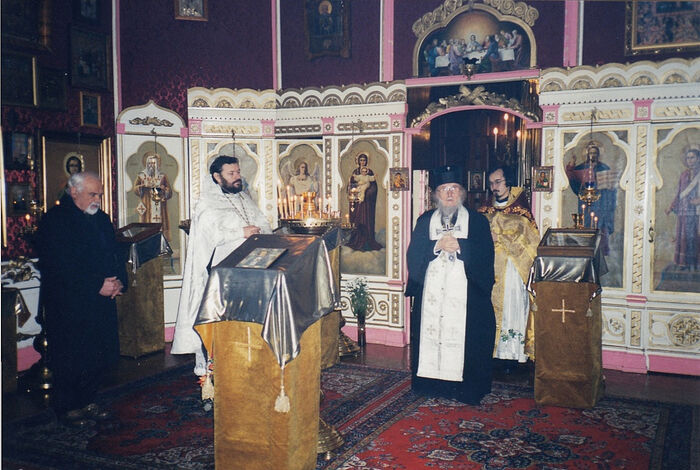 Bishop Daniel (Krstic) in the Russian church in Budapest. 2001
Bishop Daniel (Krstic) in the Russian church in Budapest. 2001
—May the Lord grant rest to his soul. Do you like living here? Have you ever had the desire to ask to be sent back to your homeland?
—This is the question of whether a person likes to live at all. A Christian will pray, work, and rejoice everywhere and in any circumstances! And he will thank God for everything. Twenty years ago I first came to Hungary and was fascinated by this country. However, in 2010, I returned to Moscow to study at Sts. Cyril and Methodius Theological Institute of Postgraduate Studies and teach at the Theology Department of Russian State Social University (RSSU). When in 2012 plans appeared to build an Orthodox church in the Hungarian spa town of Heviz, by the decision of the Holy Synod I was sent to serve in Hungary again. There is hope that the efforts and prayers of the past ten years won’t be in vain, and we will be able to build a new Orthodox church in the heart of Europe, with significant material support from the Hungarian State.
—May God grant that everything will work out. Now tell us about life in Hungary—its people and atmosphere, advantages and disadvantages. Give us the big picture of what the country looks like through the eyes of a Russian.
—I have been living in Hungary for so long that it seems that life should be just as it is here: sedate, quiet and a little provincial. Hungary can hardly be called a country for making money. Over the period of my ministry, I’ve seen that many Russian citizens couldn’t build a business here—they tried, failed, and left. The language barrier, the foreign mentality prove to be insurmountable problems for many. Such problems are probably everywhere, but the Hungarian language is generally recognized as one of the most difficult on earth. Recently, even Pope Francis during his visit to Hungary joked that Hungarian is spoken in the Kingdom of Heaven, since it takes an eternity to learn it. But if someone comes here for a vacation, he sees hospitality, a kind attitude, often being served in Russian—especially in Heviz, which captivates many who are treated at the resort or just relax. It seems that at the turn of the eighteenth century the Grand Duchess Alexandra Pavlovna best expressed her impression of Hungary by proposing to add a green stripe to its red and white flag, as she was fascinated by the nature of this country with its wooded hills. This is what the national flag of Hungary looks like today.
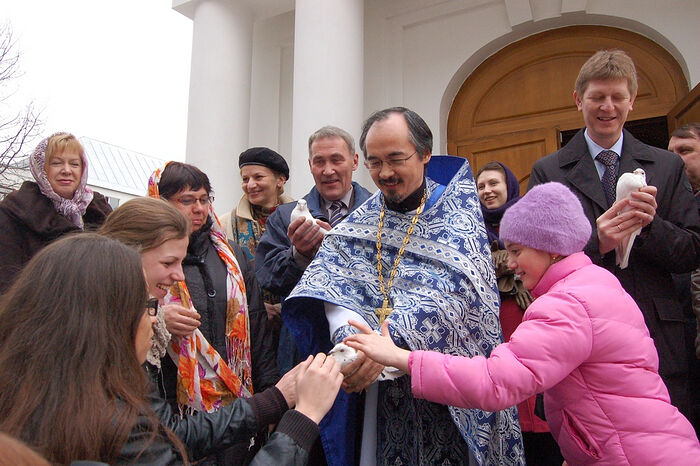 The Annunciation in the church at RSSU. 2012
The Annunciation in the church at RSSU. 2012
Hungary is a European country, and a Russian who was brought up in European culture is unlikely to find anything strange and shocking here. However, a close look within the country will reveal a wide variety of characters and traditions. Every local will tell you that Western Hungary is not at all the same as Eastern Hungary. However, the Hungarians in their centuries-old history between Germans and Slavs preserved their language, originality and culture based on Christian values. Maybe the Hungarians and the Russians read different books in their youth—Eclipse of the Crescent Moon2 and War and Peace—they are not about how to make a million, but about how to defend the Motherland or look at Heaven.
—An insightful answer ... Now let’s switch to the most interesting and important topic—the Orthodox faith in the country. How old is Orthodoxy in Hungary?
—Hungarian statehood dates back to the Baptism of the Hungarians in 1000 and the coronation of Istvan I (St. Stephen) as the King of Hungary. He received the title, “Apostolic King”, and was canonized in Catholicism and Orthodoxy. This was the time of the undivided Church. The crown of Hungary has Byzantine and Roman elements and is topped with a tilted cross. Before the Hungarians settled in their new homeland in 896 A.D., the area along the Danube had been inhabited by Slavs, especially the western part of Lake Balaton, where during the Carolingian era a Slavic principality appeared with the capital in Blatnohrad, modern-day Zalavar. Canonically, the territory was controlled by the bishop of Salzburg. In the Principality of Blaten the holy brothers Cyril and Methodius Equal-to-the-Apostles preached under Prince Kotsel. After the brothers had traveled to Rome, where Cyril reposed, Methodius became Bishop of Pannonia and received permission from the Pope to worship in Slavonic. Zalavar is located a few miles away from Heviz, and here in 2010 archaeologists discovered the oldest Glagolitic inscriptions on potsherds, which became a scientific sensation—the oldest artifact of the alphabet that Sts. Cyril and Methodius created for the Slavs.
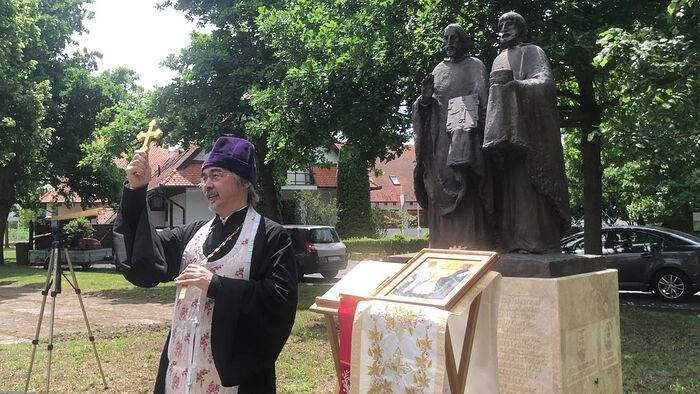 A prayer service on the feast of Sts. Cyril and Methodius in Zalavar. 2020
A prayer service on the feast of Sts. Cyril and Methodius in Zalavar. 2020
In the summer, when a museum complex is open on the territory of an ancient settlement with the foundation of the pilgrimage Church of St. Adrian, in which Sts. Cyril and Methodius used to pray, the parish of Heviz holds Orthodox services in a reconstructed church of the era of the Arpad Dynasty in honor of St. Stephen of Hungary (Istvan). On May 24, the feast of Sts. Cyril and Methodius, prayer services are held in the presence of the mayor of Zalavar. Orthodoxy has never been alien to Hungary. For example, Prince Yaroslav the Wise’s daughter Anastasia was the wife of King Andrew I of Hungary, and the Orthodox monks who arrived with her founded hermitages on the rocky shores of Lake Balaton in Tihany. This place is called “Russian stone” to this day. Hungarians are familiar with Orthodoxy of the Serbian tradition because in the mid-seventeenth century, a diocese of the Serbian Orthodox Church was set up for Serbian refugees during Ottoman rule (its present name is the Diocese of Buda).
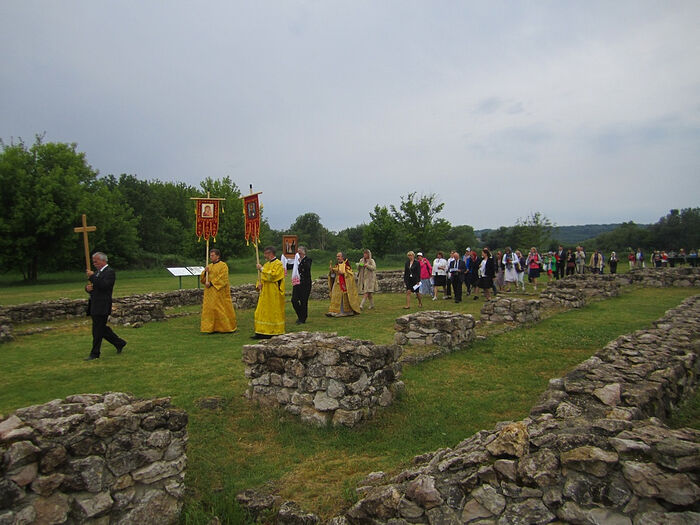 The cross procession on the feast of Sts. Cyril and Methodius in Zalavar. 2017
The cross procession on the feast of Sts. Cyril and Methodius in Zalavar. 2017
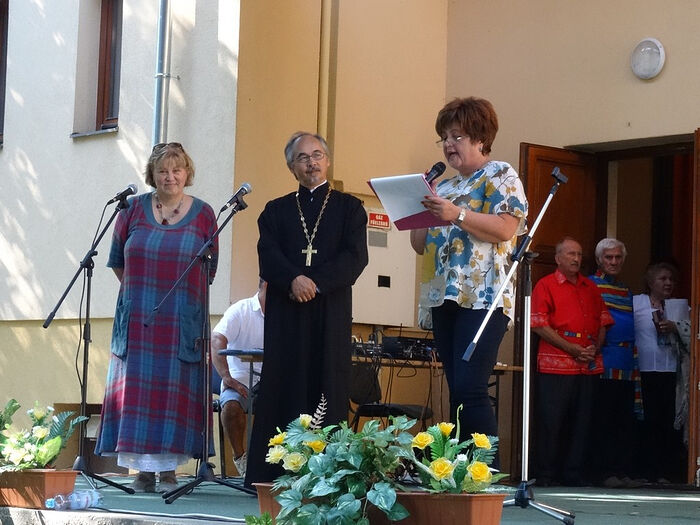 Ms. Ildiko Horvath, the Mayor of Zalavar (right), before the Russian choir performance
Ms. Ildiko Horvath, the Mayor of Zalavar (right), before the Russian choir performance
In 1690, the Holy Roman Emperor Leopold I granted the Orthodox Serbs the right to elect their own archbishop and allowed services to be celebrated. To have church services in your native language is a great privilege. In the first half of the twentieth century, the Orthodox parishes of Hungary appealed to different jurisdictions with a request to allow the celebration of services in Hungarian. But only the Moscow Patriarchate in 1949 accepted several Hungarian parishes with permission to serve in their native language and according to the new calendar. At first the parishes were united into the Hungarian Deanery, until the Budapest and Hungarian Diocese of the Moscow Patriarchate was set up in 2000.
—How many parishes are there in the diocese today? How many Orthodox (and of which jurisdictions) are there today? You mentioned Serbs...
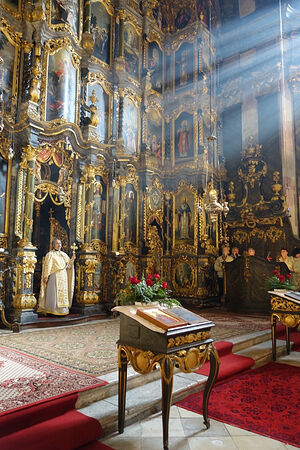 The Holy Trinity Church in Miskolc —There are two parishes of the Diocese of Hungary in Budapest that serve in Church Slavonic and adhere to the old calendar. These are the Church of St. Sergius of Radonezh on Lendvay Street (since 1949, rector: Archpriest John Kadar); and the parish of the Holy Trinity that temporarily gathers at the Dormition Cathedral in Petofi Square (since 2002, rector: Priest Dimitry Kornilov with the hired priest Svyatoslav Bulakh). The oldest Russian church of the Holy Martyr Empress Alexandra in Üröm (with Priest Dimitry Svirko) is attached to the St. Sergius parish. The youngest parish is in Heviz, a spa town near Lake Balaton (since late 2012). In total, there are three parishes and three churches where services are celebrated in Church Slavonic and the old calendar is used.
The Holy Trinity Church in Miskolc —There are two parishes of the Diocese of Hungary in Budapest that serve in Church Slavonic and adhere to the old calendar. These are the Church of St. Sergius of Radonezh on Lendvay Street (since 1949, rector: Archpriest John Kadar); and the parish of the Holy Trinity that temporarily gathers at the Dormition Cathedral in Petofi Square (since 2002, rector: Priest Dimitry Kornilov with the hired priest Svyatoslav Bulakh). The oldest Russian church of the Holy Martyr Empress Alexandra in Üröm (with Priest Dimitry Svirko) is attached to the St. Sergius parish. The youngest parish is in Heviz, a spa town near Lake Balaton (since late 2012). In total, there are three parishes and three churches where services are celebrated in Church Slavonic and the old calendar is used.
In addition to them, there are seven Hungarian-speaking parishes adhering to the new calendar: the parish of the Dormition Cathedral, two Holy Trinity parishes in Miskolc and Debrecen, two parishes of St. George the Victorious in Nyíregyháza and Szeged, and two St. Nicholas Churches in Gyöngyös and Tokaj.
Hungarian Orthodoxy has a rich spiritual heritage and worthy successors. Liturgical texts, many Patristic works and those by contemporary spiritual authors were translated into Hungarian by the ever-memorable Protopresbyter Feriz Berki. His work is being carried on by the scholar Archpriest Tibor Imrényi, Archpriest Kirill Tatarka and Archpriest Stephen Magyar. Marta Varga has been successfully publishing Orthodox literature for many years. Priest Joseph Krank is responsible for work with children; and the talented musicians—the rector of the church in Debrecen, Priest Barnabas Sipos, and the choir director Marina Lepakhina-Bilku—are involved in harmonizing Hungarian liturgical texts for church singing.
The five Orthodox jurisdictions represented in Hungary are recognized by law as historical Churches and are full-fledged religious organizations. These are the Diocese of Buda (the Serbian Orthodox Church), the Diocese of Gyula (the Romanian Orthodox Church), the Bulgarian Orthodox Church in Hungary, the Hungarian Exarchate (the Patriarchate of Constantinople) and the Diocese of Hungary (the Moscow Patriarchate). According to the 2001 census, there are 15,000 Orthodox Christians in Hungary, which is about 0.15 percent of the population, mainly national minorities. 3,500 of them identified themselves as parishioners of the Russian Orthodox Church.

